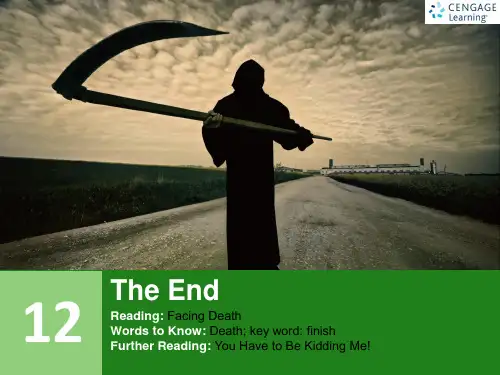大学英语泛读教程3(第三版)-电子教案Unit 12
泛读教程3教案

泛读教程3教案教案标题:泛读教程3教案教案目标:1. 帮助学生提高泛读技巧和阅读理解能力;2. 培养学生的阅读兴趣和阅读习惯;3. 培养学生的自主学习和合作学习能力。
教学重点:1. 培养学生的泛读技巧;2. 培养学生的阅读理解能力。
教学难点:1. 提高学生的阅读速度和准确性;2. 培养学生的阅读思维和分析能力。
教学准备:1. 泛读教程3教材;2. 多媒体设备;3. 学生练习册;4. 阅读理解练习题。
教学过程:一、导入(5分钟)1. 创造一个愉快的学习氛围,引起学生的注意;2. 提问学生对泛读的理解和经验。
二、预习(10分钟)1. 让学生在课前预习教材中的文章标题和段落标题;2. 学生扫读文章,了解文章大意。
三、阅读与讨论(20分钟)1. 学生独立阅读教材中的一篇文章;2. 学生小组内讨论文章的主题、中心思想和关键细节;3. 学生展示自己的理解和观点。
四、泛读练习(15分钟)1. 学生进行泛读练习,尽量提高阅读速度和准确性;2. 引导学生使用快速阅读技巧,如扫读、略读和跳读。
五、阅读理解(15分钟)1. 学生独立完成阅读理解练习题;2. 学生交流答案并进行讨论;3. 教师给予指导和解释。
六、巩固与拓展(10分钟)1. 学生根据自己的理解和感受,写下对本课内容的总结;2. 学生分享自己的总结,并相互评价。
七、作业布置(5分钟)1. 布置阅读任务,要求学生阅读下一篇文章;2. 布置练习题,要求学生完成阅读理解练习。
教学反思:1. 教师应及时给予学生反馈,鼓励他们的努力和进步;2. 教师要关注学生的阅读兴趣和阅读习惯,适时调整教学策略;3. 教师要鼓励学生进行合作学习,促进彼此之间的互动和学习成长。
以上是一个关于泛读教程3的教案示例,希望对您有所帮助。
根据实际情况,您可以根据教学目标和学生的实际情况进行适当的调整和修改。
高教版大学英语泛读教程4(第三版)电子教案Unit 12

“clean”? Vocabulary
a. Neatly.
c. In tune.
b. Spick and span.
d. Ply their trade.
U12-p.142
c 4. Which of the following words or expressions does NOT refer to dead
U12-p.141
Reading Comprehension
Based on the reading text, choose the most appropriate answer to the following questions.
d 1. Which of the following statements is NOT true? Detail
d. Buddhists never touch dead bodies. a 2. What is meant by the phrasal verb “dig in”? Vocabulary
a. Eat.
c. Worship.
b. Pray.
d. Offer.
b 3. Which of the following words or expressions is used in the text to mean
U12-p.140-141
A Do You Get It?
Multiple Matching
There are three main passages in the reading text.
Which of them refers to … __c___ 1. washing rituals? __c___ 2. people who remove their clothes? __a___ 3. a place where people worship? __c___ 4. the burning of a body? __a___ 5. the possibility that the dead can influence our lives? __b___ 6. people who are paid for their services? __b___ 7. a historical period? __c___ 8. something that doesn’t last forever?
Keys_to_Reading_Course_3 泛读教程 第三册 (王守仁 著) 上海外语教育出版社 课后答案

Keys to Reading Course 3Unit 1Reading Strategies Section A Word Pretest 1-5.BCBBB 6-10.AACCB Reading Skill 2-5.CBCA6-9.BBAAV ocabulary Building 1.a.practicable/practicalb.practicec.practicesd.practicable/practicale.practiceda.worthlessb.worthyc.worthwhiled.worthe.worth a.vary b.variety c.variation d.various/varied e.Various a.absorbing b.absorbed c.absorb d.absorption e.absorbent2.1.a.effective b.efficient c.effective2.a.technology b.technique3.a.middle b.medium c.mediumClozegoing/about/tryingexpectations/predictions questionsanswers predictions/expectations tell know/foretell enddevelop/presentworthSection B 1-5.TFTTC6-10.BCCTF 11-14:FCAAC16-17:CASection C 1-5.FFTFF 6-8.TTT Keys to Reading Course 3Unit 2Education Section A Word Pretest 1-5.ABACC 6-8.ABAReading Skill 4-6.CBB 1-6.FTFFTTV ocabulary Building 1.mess 2.preference 3.aimlessly 4.remarkable/marked 5.decisive6.shipment 7.fiery 8.physically 9.action 10.housing课后答案网 ww w.kh da w.c o m2.1.a.aptitude b.attitude2.a.account b.counted c.counted3.a.talent b.intelligence Cloze other just/only has some/many thanrefuse see/know/understand thatwithout If ready/willing/educated/taught wrong/incorrect/erroneousSection B 1-5.ACCCCCAC 11-14:BABASection CDDACKeys to Reading Course 3Unit 3Body Language Section A Word Pretest1-5.ABCCB 6-9.DCDCReading Skill2-5.BABC 6-10.ACCBCV ocabulary Building Use of English 1.admission admit admissible admissibly reliance rely reliable reliably definition define definite definitely assumption assume assumed/assuming assumedly/assumingly behavior behave behavioral behaviorally variety vary various/varied variously/variedly part/partiality part partial partially manager/management manage managerial managerially correlation correlate correlative correlatively adaption/adaptation adapt adaptive adaptively 2.1.a.inspired b.aspired c.inspired2.a.token b.badges c.token3.a.contemporaries b.temporary c.contemporary Clozecommunicateways/means//onesusing/sayinginofmessage课后答案网 ww w.kh da w .c o mmeet/have/encounter/experience causes meaning toSection B 1-5.BABBA 6-10.CFFTT 11-15:TFCCBSection C 1-5.BBDDBAFF 11-14.TFFTKeys to Reading Course 3Unit 4Animals Section A Word Pretest1-5.CACAA 6-10.BBBCCReading Skill 2-5.BBAC 6-10.BCCAA V ocabulary Building 1.1.moist2.betrayal3.exclusively4.inhumane5.amazed/amazing6.endangered7.marvels8.deadly2.1.a.dessert b.deserted2.a.favorite b.favorable c.favorable3.a.awardedb.rewardc.awardedCloze parents idea at/by seenlandmarks instance/example migrateguide/direct poleeffect/influenceIt/This if/whether experimentsSection B BFT6-10.FBCAC11-15:CBACCSection C 1-5.FFTFF 6-10.FTTFT Keys to Reading Course 3Unit 5History Section A Word Pretest 1-5.CAABC 6-9.ACCC Reading Skill 2-6.CABCB1-6.FFTFTT课后答案网 ww w.kh da w .c o mV ocabulary Building 答案略,自己查字典2.1.a.Historical b.history2.a.rejected b.resist3.a.test/analyze b.analyze Clozeexisted/appeared over head/brain bodyfound language use/value/significance/important single passed ahead survival/existenceSection B 1-5.CABCB 6-10.BTTTF 11-15:TTCACSection C 1-5.BBAAA6-8.CBCUnit 6LanguageSection A Word Pretest1-5.CACBA 6-12.BACABABReading Skill 3-5.CAA 6-10.CACCAV ocabulary Building 答案略,自己查字典2.1.a.peculiar b.particular c.particular2.a.assess b.access c.access3.a.resources b.source c.sources Cloze sex Men differs compliment/word complimenting causes makeslanguages have outside understood have use circle/world/fieldSection B 1-5.CABBA 6-10.CBCCC11-17:CBACCBASection C课后答案网ww w.kh da w .c o m1-5.BBCAB 6-8.BACCBUnit 7Space Section A Word Pretest 1-5.ABABC 6-8.BACReading Skill 1-5.BBBCC6-8.BCBV ocabulary Building 1.deduced 2.behavior 3.adhere4.replacement5.option6.delicacy7.enormous8.pursuit2.1.a.inquired b.required c.inquire d.requiredpatible parable patible parableCloze satellite some space asked/wondered life sort/kind orbiting/going/circling have living were believe own solar where likely livingthroughSection B 1-5.FTFFT6-10.TTTTF11-15:FFBBC 16-18.ACCSection C 1-5.BCBCC 6-8.AED 1-6.EBAFDC Unit 8Women Section A Word Pretest1-5.BCABC 6-10.BBCCA Reading Skill 1-5.CBABC6-10.BCCCCV ocabulary Building 答案略,自己查字典2.1.a.jobb.careerc.jobsd.career课后答案网 ww w.kh da w .c o m2.a.principal b.principles c.principle d.principle3.a.feminine b.female c.feminineClozeacceptable domestic property wages husband divorce claims legalsuit permitted make excluded lacked belonged determined Section B 1-5.BACCC 6-10.CACCC 11-15.AABBA 16-19.CTTFSection C AACB Unit 9Cities Section A Word Pretest 1-5.BAABC 6-10.ACBBAReading Skill 1-5.CACCB6-12.BBBBACBV ocabulary Building 1.1.typifies2.dominant3.familialpetitive5.vibrate6.descended7.departure 8.boom 9.countless 10.symbolizes2.1.a.recreation b.recreate c.recreation2.a.rhythm b.rhyme c.rhymes d.rhythmCloze sea within of divides built/constructed/completedcelebratedinside/inattracttogether whenSection B 1-5.FTFTTBBC11-17.BAACCACSection C 1-5.BAACA 6-10.BCCCCUnit 10Cross-cultural Communication Section A Word Pretest1-5.CABCB 6-10.BBBAB Reading Skill课后答案网ww w.kh da w .c o m1-5.CBCAC ABBV ocabulary Building 答案略,自己查字典2.1.a.assure b.ensure c.assured d.ensure2.a.arises b.raised c.rise d.raised e.arisen3.a.clue b.cues c.clue d.cueCloze well separating/isolating is own close needlook order respectfpllowprior sign/cue help was/were elseSection B1-5.BBCTT6-10FBCAC 11-15.ACTFFSection C1-8.TFFTFFFFUnit 11Information Retrieval Section A Word Pretest1-5.ACBCB 6-8.ABBReading Skill 1-5.BCBACCCCV ocabulary Building 答案略,自己查字典1.extension 2.ambiguity 3.original 4.specified 5.additional 6.unambiguously 7.explosion rmation9.specialized10.narrative11.established2.1.a.transform b.transferred c.transferred d.transformed2.a.lonely b.alone c.lonely d.alone Cloze library amounted own burned/destroyedbycountriessendsuggestion/proposal library Section B 1-5.ACBCB6-10.ACCAC 11-17.ABABBAB课后答案网 ww w.kh da w .c o mSection C 1-5.BCACC 6-10.CBCCC Unit 12Environment Section A Word Pretest BBC 6-12.AACCCBA Reading Skill 1-5.CABBC6-10.CBBV ocabulary Building 1.1.reaction2.mass3.polluting4.planetary5.suspicious6.alarming7.emitted 8.emerged2.1.a.warned b.threatened2.a.spread b.spread c.sprayed3.a.emergency b.emergenceCloze solve communities creative prevention disposalresourcesrecyclingwasteincrease place measures amountSection B 1-5.FFTTB6-10.CACFT11-18.FFABCCBCSection C1-8.BCAACCBC课后答案网 ww w.kh da w.c o m。
《泛读教程》_第三册(Unit1~Unit10)

《泛读教程》第三册王守仁(Unit1~Unit10) 参考答案Unit 1Section AWord PretestBCBBBAACCBReading SkillCBCABBAAVocabulary Building1 practicable practice practices practical practiced2worthless worthy worthwhile worth worth3vary variety variation various various4absorbing absorbed absorb absorption absorbent21effective efficient effective2technology technique3middle medium mediumClozegoing expectations questions answers predictions tell know end develop worthSection BTFTT CBCC TFF CAACCASection CFFTFFTTTUnit 2Section AWord PretestABACCABABCCReading SkillCBB FTFFTTVocabulary Building11mess 2preference 3aimlessly 4remarkable 5decisive 6shipment 7fiery 8physically 9action 10housing21aptitude attitude2account counted counted3talent intelligenceClozeother just has some than refuse see that without if ready wrongSection BACCCCCCCACBABASection CCCDDACUnit 3Section AWord PretestABCCBDCDCReading SkillBABCAACBCVocabulary Building1Admission admit admissible admissiblyReliance rely reliable reliablyDefinition define definite definitelyAssumption assume assumed assumedlyBehavior behave behavioral behaviorallyVariety vary various variouslyPart part partial partiallyManager manage managerial manageriallyCorrelation correlate correlative correlativelyAdaptation adapt adaptive adaptively21inspired aspired inspired2token badges token3contemporaries temporary contemporaryClozeCommunicate ways using in of message meet causes meaning to eyesSection BBABBAC FFTTTF CCBSection CBBDDBCCA FFTFFTUnit 4Section AWord PretestCACAABBBCCReading SkillBBACBCCAAVocabulary Building11moist 2betrayal 3exclusively 4inhumane 5amazed 6endangered 7marvels 8deadly21dessert deserted2favourite favorable favorable3awarded reward awardedClozeParents idea at seen landmarks instance migrate guide pole effect it if experimentsSection BCCB FTF BCACCBACCSection CFFTFFFTTFTUnit 5Section AWord PretestCAABCACCCReading SkillCABCB FFTFTTVocabulary Building1Assumption assume assumed assumedly Acknowledgement acknowledge acknowledgedly Reflection reflect reflective reflectively Domination dominate dominant dominantly Category categorize categorical categoricallyImplication imply implicative implicativelyReassurance reassure reassuring reassuringlyDefinition define definite definitely21historical historic2rejected resist3test analyzedClozeExisted over head body found language use single passed ahead survival handlingSection BCABCBB TTTFTT CACSection CBBAAACBCUnit 6Section AWord PretestC ACBABACABABReading SkillCAACACCAVocabulary BuildingAvailability avail available availablyConquest conquer conquering conqueringlyLuxury luxuriate luxurious luxuriouslyOrgin orginate original originallyOccurrence occur occurrentSystem systematize systematical systematicallyPhonology (这个是没有动词形式的)phonological phonologicallyDecision decide decided decidedlyVariety vary various variouslySuperiority (这个是没有动词形式的)superior superiorlyPeculiar particular particularAssess access accessResources source sourcesClozeSex men differs compliment complimenting causes makes languages have outside understood have use circleSection BCBBBACBCCCCBACCBASection CBBCABBACCBUnit 7Section AWord PretestABABCBACReading SkillBBBCCBCBVocabulary BuildingDeduced behavior adhere replacement option delicacy enormous pursuitInquired required inquire requiredCompatible comparable compatible comparableClozeSatellite some space asked life sort orbiting have living were believe own solar where likely living throughSection BFTFFTTTTTFFFBBCACCSection CBCBCCAEDEBAFDCUnit 8Section AWord PretestBCABCBBCCAReading SkillCBABCBCCCCVocabulary BuildingOccupation occupy occupational occupationallySegregation segregate segregated(这个没有副词)Discrimination discriminate discriminating discriminatingly Enforcement enforce enforceable enforceablyExclusion exclude exclusive exclusivelyPerseverance persevere persevering perseveringlyConviction convict convictive convectivelyAmendment amend amendable(这个没有副词)Superficiality superficialize superficial superficially Spectator spectate spectatorial (这个没有副词)Job career jobs careerPrincipal principles principal principleFeminine female feminineClozeAcceptable domestic property wages husband divorce claims legal suit permitted make excluded lacked belonged determined Section BBACCCCACCCAABBACTTFSection CCCAACBUnit 9Section AWord PretestBAABCACBBABCReading SkillCACCBBBBBACBVocabulary BuildingTypifies dominant familial competitive vibrate descended departure boom countless symbolizesRecreation recreates recreationRhythm rhyme rhymes rhythmClozeSea within of divides built celebrated inside attract together whenSection BFTFTTCCBBCBAACCACSection CBAACABCCCCUnit 10Section AWord PretestCABCBBBBABReading SkillCBCACCCABBVocabulary BuildingConsequence(这个没有动词形式)consequent consequently Sophistication sophisticate sophisticated sophisticatedly Reference refer referable referablyConversation converse conversational conversationally Space space spatial spatiallyDetachment detach detachable detachablyIntervention intervene intervening(这个没有副词)Type typify typical typicallyAssure ensure assured ensureArises raised rise raised arisenClue cues clue cueClozeWell separating is own close need look order respect follow prior sign help was elseSection BBBCTTFBCACACTFFSection CTFFTFFFF。
高教版大学英语泛读教程4(第三版)电子教案Unit 12

Expressing Grief
In some cultures, extreme displays of grief are a way of demonstrating the strength of one’s feelings for the departed. However, historically, these outpourings of distress need not always come from the nearest and dearest of the deceased. For the ancient Romans, for example, hiring professional mourners was a common way of putting on a suitable display of public lamentation. These people were paid to shriek and even tear their hair out in a frenzy of grief. Interestingly, wailers were also hired for funerals in Victorian England, and professional mourners continue to ply their trade in parts of Africa, the Middle East and China to this day. Sometimes these professionals can actually add spice to an otherwise morbid occasion by singing or dancing.
大学英语泛读第三版教案

课程名称:大学英语泛读教程(第三版)授课对象:大学英语专业学生授课时间:2课时教学目标:1. 提高学生的英语阅读理解能力,培养学生的英语阅读兴趣。
2. 培养学生的批判性思维和跨文化交际能力。
3. 增强学生的英语词汇量和语法知识。
4. 培养学生的自主学习能力和合作学习能力。
教学重点:1. 理解文章的主旨大意和细节内容。
2. 掌握文章的写作技巧和修辞手法。
3. 学会运用英语进行批判性思考和表达。
4. 了解跨文化背景知识。
教学难点:1. 理解文章的深层含义和作者的写作意图。
2. 灵活运用语法知识进行英语表达。
3. 提高学生的跨文化交际能力。
教学方法和手段:1. 讲授法:讲解文章的背景知识、写作技巧和修辞手法。
2. 讨论法:引导学生进行小组讨论,分享观点,提高学生的口语表达能力。
3. 案例分析法:通过分析典型文章,让学生掌握阅读技巧。
4. 角色扮演法:让学生模拟文章中的角色,提高学生的英语实际运用能力。
5. 多媒体教学:利用PPT、视频等手段,丰富教学内容。
教学内容和过程:第一课时:一、导入1. 介绍课程背景和教学目标。
2. 引导学生思考阅读的重要性。
二、课文讲解1. 介绍文章的背景和作者。
2. 分析文章的主旨大意和细节内容。
3. 讲解文章的写作技巧和修辞手法。
三、课堂活动1. 小组讨论:让学生分组讨论文章的主题,分享各自的观点。
2. 角色扮演:让学生模拟文章中的角色,提高学生的英语实际运用能力。
四、作业布置1. 完成课后练习题,巩固所学知识。
2. 预习下一课内容。
第二课时:一、复习上节课内容1. 复习课文中的重点词汇和短语。
2. 复习文章的写作技巧和修辞手法。
二、阅读理解练习1. 阅读一篇新的英语文章,分析文章的主旨大意和细节内容。
2. 学生互相讨论,分享阅读心得。
三、语法讲解1. 讲解与课文相关的语法知识。
2. 布置语法练习题。
四、课堂活动1. 小组讨论:让学生分组讨论文章的主题,分享各自的观点。
2. 角色扮演:让学生模拟文章中的角色,提高学生的英语实际运用能力。
unit 12 英语泛读教程第三册
Unit 12 Why Are Y ou So Smart?ⅠObjectives1.Understanding the text2.Mastery of some language points3. Learning the hereditary factors that determine thought process2. Mastery of some difficult language points3. Learning the hereditary factors that determine thought processdetermine thought process2. Students might have difficulty in some of the words and phrases.3.Students need to learn some general knowledge of genes and their influeceIV Time ArrangementAbout two periods of class will be used for the analysis and discussion of the passage itself.Total class hours: three periodsAbout the author:Karen E. Wright, Ph.D. Associate Member, Department of Educational Psychology and Special Education, and Associate Professor, College of Nursing.Teaching areas: Counseling; family dynamics; grief, loss and bereavement; health and wellness.Research interests: Loss, grief & bereavement; grief & bereavement counseling; family coping; health psychology; child & adolescent development; quality of life; chronic & terminal illness; counselor education; women's issues.2. Text analysis1) Warm-up question:Have you ever taken a IQ test? Do you believe it? What is the advantage and disadvantage of being measured by such test?2) Language notes:1. whether you wind up in jail.(是否你将身陷牢狱。
大学英语泛读教程3(第三版)-电子教案Unit 11
A Do You Get It?
Multiple Matching
Reread the four paragraph (A-D) in the text.
Which of the paragraphs mentions … __A___ 1. mistakes by fishermen? __B___ 2. species of fish? __C___ 3. flexible laws? __B___ 4. fish that eat other fish? __D___ 5. an environmental agency? __D___ 6. reading material? __A___ 7. fishing in the deepest parts of the sea? __C___ 8. areas where fishing is not allowed?
U11-p.130
Track 25
A look at the official statistics shows us that things are getting worse and worse. The United Nations’ Food and Agriculture Organization issues a biannual report detailing the state of the world’s oceans, and the latest findings don’t make for comfortable reading. Most of the stocks of the top ten fishing species are classified as fully exploited, with some classified as over-exploited, meaning they have been fished at a level that cannot be sustained. Meanwhile, a shocking 90 percent of large predatory fish stocks have been completely wiped out. These include tuna and cod, two of the most popular fish for the dinner table.
大学英语泛读教程3(第三版)-电子教案Unit 9
Track 20
The mudstone was not the only rock to catch Curiosity’s attention. The rover accidentally ran over another stone, dubbed Tintina, splitting it in two. The speckled, white surface of the interior is considered a sign of hydrated minerals – elements caused by water. This further supports the view that water once flowed through the valleys of Mars. Fissures, or cracks, which have been observed and examined in the surface of rocks, also attest to the likelihood of water at some stage in Mars’s history. Other aspects of Mars’s terrain also point to ancient river activity. A low area of land near where Curiosity landed contains multiple features that scientists have said closely resemble geological characteristics in riverbeds on our planet.
Before You Start
英语专业 英语泛读3 第三册 教案
prompt to cause
rage to burn out of control
rap n. accusation charge
v. criticize
rock to shock; to surprise
rout defeat completely
row a quarrel
3.3.Read English novels
参考资料(含参考书、文献等,有章节教案的本项可不填):
1.1.新编英语教程参考答案(1-4册).上海外语教育出版社,2004.
2.2.Nuttall, C. Teaching Reading Skills in a Foreign Language [M].上海外语教育出版社,2002.
nab to capture
net to take possession of; capture
nod approval
office an important government position
opt choose; decide
oust take power away from
pact a solemn agreement
外语系
教案
_2009_~2010学年第1学期
学院名称外语系
系(部)英语专业
课程名称英语泛读(3)________
授课对象2008级本科
授课教师__________
职称教授____________
教材名称新编英语泛读教程(第三册)
2009年8月25日
保定学院课程教案(课时单元备课)
授课题目(或主题):Unit 1ReadingStrategies
- 1、下载文档前请自行甄别文档内容的完整性,平台不提供额外的编辑、内容补充、找答案等附加服务。
- 2、"仅部分预览"的文档,不可在线预览部分如存在完整性等问题,可反馈申请退款(可完整预览的文档不适用该条件!)。
- 3、如文档侵犯您的权益,请联系客服反馈,我们会尽快为您处理(人工客服工作时间:9:00-18:30)。
U12-p.146
Reading Comprehension
Based on the reading text, choose the most appropriate answer to the following questions.
a 1. Why were rotten teeth seen as a sign of prestige? Detail a. Because sweet food was expensive. b. Because dentistry was not cheap in those days. c. Because it was considered beautiful. d. Because only married women had black teeth.
U12-p.144
Track 27
A Kick in the Teeth
Everyone loves a nice toothy grin, right? Well, not the Elizabethan English, apparently. In the 16th century, sweet delicacies were treats available only to the wealthy. For this reason, bad teeth were seen as a sign of prestige and it was not uncommon for society’s richest to blacken their teeth in an attempt to demonstrate their status. As daft as this practice seems, the darkening of teeth was not confined to the 16th century English. For centuries, the Japanese died their teeth black. Although, it was mainly women who did this to demonstrate they had come of age or were married, aristocratic men and soldiers who had been injured also adopted the habit. Unlike the Elizabethans, though, the Japanese were actually looking after the teeth, as the dye provided a coating that protected the teeth from decay.
Before You Start
• What are the current crazes in your country? How are people active in these crazes?
• Can you remember any interesting trends from previous eras? Give some examples.
b 4. What does the author think about the fish-swallowing fad? Vocabulary a. It was a stormy incident. b. It was not a big deal. c. It was not something to be proud of. d. It was quite a common occurrence.
U12-p.146
c 3. What does the author mean by “shaking their heads”? Vocabulary a. disagreeing with something b. getting annoyed with someone c. finding something hard to believe d. feeling disappointed by something
U12-p.144
Track 27
All the Moves
Dance marathons have to rank among the craziest crazes imaginable. Taking place around the same time that students were gobbling fish, these competitions involved contestants dancing for weeks or even months on end in the hope of taking home a cash prize. Couples would be allowed short breaks every hour and 12 small meals throughout the day. The public paid a small fee to watch the sorry spectacle and, once they had purchased their tickets, they were allowed to come and go as they pleased. Part of the perversity of the whole thing was that the viewers weren’t watching the event to pick up the latest moves on the dance floor, but out of morbid fascination and amusement. Most of the time, the participants were merely stumbling around trying to keep their feet. The competition ended when one couple was left standing, the others having quit or dropped from exhaustion. After several people died, and the events were condemned as cruel and dangerous, dance marathons largely died out. The fad inspired the novel and subsequent movie They Shoot Horses Don’t They?
12
The Next Big Thing
Reading: Do You Remember When We Used to …? Three Bizarre Fads from History Words to Know: History; key word: interest Further Reading: Going Viral: The Internet Memes that You Just Can’t Avoid
• Have any trends from foreign countries become popular? If so, what has made the trends receive considerable publicity?
U12-p.143
Reading
Track 27
Do you Remember When We Used to …?
d 2. Which of the following is given as a reason for people watching the dance marathons? Detail a. They wanted to learn how to dance. b. They thought the events were moving. c. They wanted to receive a free meal. d. They found the dancers funny.
U12-p.144-145
A Do You Get It?
Multiple Matching
Reread the three fads in the text.
Which of the fads … __c___ 1. was dangerous? __a___ 2. was related to money and class? __b___ 3. caused protests by rights groups? __a___ 4. was most welcomed by women? __c___ 5. involved a paying audience? __b___ 6. started for unknown reasons? __a___ 7. relates to personal hygiene?
U12-p.144
Track 27
A Fish Out of Water
Quite how swallowing live fish became a popular fad with American college students in the late 1930s is anyone’s guess, but several sources have traced the origins of this activity back to a young Harvard freshman called Lothrop Withington, Jr. Responding to a dare from his roommates, Withington ate a live fish in front of a crowd of onlookers at the Harvard Union. For reasons unknown, his antics sparked a frenzy for feasting on goldfish, and students around the country joined in. At the time animals rights groups were up in arms, and the media said it was a sign of the decadence of the youth. Looking back, as silly as the whole thing was, it all seems like a storm in a teacup.
